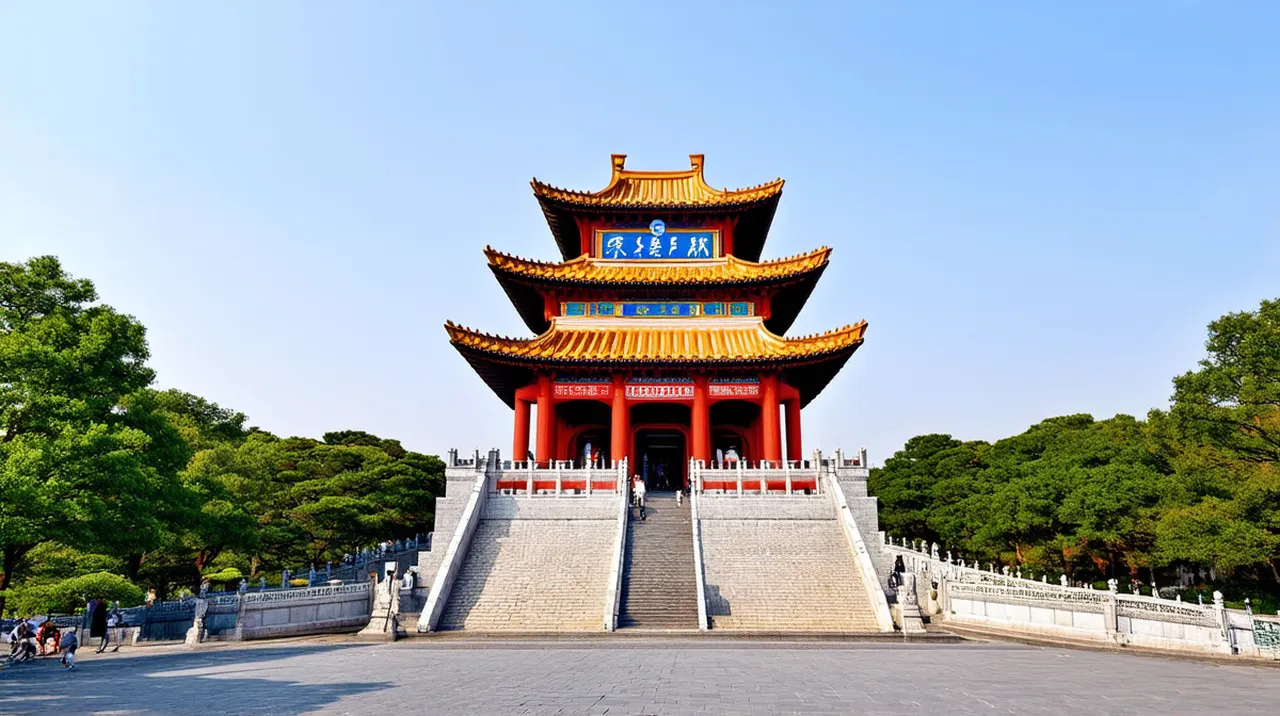
Nanjing Landmarks: Explore 10 Iconic Sites in the City
Table of Contents
Nanjing Landmarks
Nanjing, a city steeped in history and culture, boasts some of the most captivating landmarks in China. As the former capital, it is home to a myriad of historical sites that narrate tales of ancient dynasties, remarkable architecture, and rich traditions. In this article, we’ll delve into 10 must-visit Nanjing landmarks that capture the essence of this vibrant city. From majestic mausoleums and serene parks to bustling streets filled with stories, these landmarks offer a unique vantage point into Nanjing’s fascinating past and lively present. Join us as we explore the iconic wonders that make Nanjing a destination worth visiting.
Want to find the best travel deals for this destination? personalized adventure planner with our adventure planning specialist!
1. The Ming Xiaoling Mausoleum: A Testament to Imperial Grandeur

When visiting Nanjing, one of the must-see Nanjing landmarks is the Ming Xiaoling Mausoleum. This impressive site is not only the burial ground of the first emperor of the Ming Dynasty but also a stunning example of ancient Chinese architecture. As you walk through the vast grounds, you’ll find yourself immersed in history.
The mausoleum is renowned for its exquisite stone carvings, including the legendary Spirit Way lined with majestic animal statues. Moreover, the dramatic natural setting adds to its beauty, surrounded by lush hills and serene landscapes. Hence, taking a moment to appreciate the tranquility is essential.
Tip: Visiting early in the morning allows you to experience the site in peace before the crowds arrive.
2. Nanjing City Wall: Walk Through History

The Nanjing City Wall is one of the longest city walls in the world and a key piece of Nanjing’s rich heritage. Initially constructed during the Ming Dynasty, it spans over 35 kilometers and offers visitors an opportunity to walk through centuries of history. You can explore intact sections, which provide panoramic views of the city.
As you stroll along the wall, notice the impressive watchtowers and bastions that once protected the city. Additionally, you’ll find plenty of informative plaques detailing its storied past, making this landmark both educational and awe-inspiring. Thus, be sure to take your time as you absorb the panoramic views of Nanjing.
Pro-tip: Bring a camera; the sunset views from the wall are breathtaking!
3. The Nanjing Massacre Memorial Hall: Remembering the Past

The Nanjing Massacre Memorial Hall is a poignant reminder of the tragic Events that occurred in 1937. This site serves not just as a memorial but also as an educational space aimed at promoting peace and healing. As you walk through its exhibits, you’ll find powerful photographs and testimonies that narrate the harrowing stories of that time.
Visitors should take their time to fully experience the somber atmosphere. The architecture itself is striking and designed to evoke reflection. Moreover, interactive displays and guided tours help put the historical context into perspective, making it a must-visit on your journey through Nanjing.
Remember: Approaching the subject matter with sensitivity is essential during your visit.
4. Dr. Sun Yat-sen’s Mausoleum: A Tribute to a Revolutionary

Dr. Sun Yat-sen’s Mausoleum stands as a pivotal landmark in Nanjing, symbolizing the deep respect for the father of modern China. Located on the tranquil Purple Mountain, this mausoleum attracts visitors not just for its grandeur but also for its historical significance. Constructed in 1926, the structure is marked by its elegant archway and monumental staircase.
As you ascend the 392 steps, you will be mesmerized by the stunning views of the surrounding landscape. Furthermore, the main hall houses a large statue of Sun Yat-sen, which serves as a poignant reminder of his revolutionary ideals.
Many visitors take time to reflect here, surrounded by the serene ambiance that envelops this sacred site. Therefore, if you’re exploring Nanjing landmarks, this mausoleum is undoubtedly a place you should not miss.
5. Xuanwu Lake: Nature and Serenity Amidst Urban Life

Xuanwu Lake is often regarded as the green heart of Nanjing, offering a delightful escape from the bustling city life. This stunning park features five interconnected islands, each adorned with beautiful pavilions and lush gardens. Visitors can enjoy a leisurely stroll along the scenic trails while marveling at the vistas of the Purple Mountain.
Interestingly, the lake provides various recreational Activities, such as boating and cycling. On weekends, you can find families having picnics or couples enjoying romantic walks, creating a lively atmosphere. Moreover, the peaceful environment makes it a perfect spot to unwind and recharge.
Don’t forget your camera, as Xuanwu Lake is known for its picturesque beauty, especially during sunrise and sunset. Thus, whether you’re after tranquility or engaging Activities, this landmark truly captures the essence of Nanjing’s charm.
6. The Confucius Temple: A Cultural Hub of Education and Philosophy
Located by the Qinhuai River, the Confucius Temple is not only a beautiful landmark but also a vibrant center of culture and education in Nanjing. Built to honor Confucius, this site includes a vast complex with classical architecture, serene gardens, and historical exhibits. As you walk through the temple grounds, you’ll feel a deep connection to the philosophical teachings of Confucius.
Moreover, the area surrounding the temple is filled with shops and eateries, offering a taste of local cuisine. Every year, the temple hosts festivals that celebrate Chinese traditions, which adds an exciting ambiance to the environment.
In summary, the Confucius Temple represents more than just a landmark; it is a reminder of the cultural roots that define Nanjing. Whether you are an architecture enthusiast or a history buff, this site is sure to enrich your understanding of Chinese heritage.
7. The Presidential Palace: Witness to Political Change
Pro Tip: Book your Nanjing adventures in advance through Viator for the best deals!
The Presidential Palace in Nanjing is a remarkable representation of the city’s history and political transformation. Originally built in the late Ming Dynasty, this landmark later became the official residence of several prominent leaders during the Republic of China. Today, it stands as a symbol of political change through various eras.
As you stroll through the beautifully landscaped gardens, you will encounter various halls and exhibition spaces that narrate the rich political history of China. Furthermore, the architecture showcases a unique blend of Eastern and Western styles, reflecting the cultural exchange prevalent during its construction.
To enhance your visit, consider joining a guided tour. This way, you’ll gain deeper insights into the historical significance of the palace. In summary, the Presidential Palace is not just a site of beauty but also a chronicle of changing times.
8. Zhonghua Gate: The Oldest City Gate in Nanjing
Insider Tip: Get the most out of your Nanjing visit with guided tours!
Zhonghua Gate, also known as the “Gate of China,” is one of the oldest city gates in Nanjing and an essential part of the Nanjing Landmarks. This ancient structure was built during the Ming Dynasty and is famous for its defensive architecture. Notably, it features a complex system of walls and towers, showcasing the sophisticated military strategies of the time.
Visitors can explore the various levels of the gate, offering impressive views of the surrounding area. Stand atop the walls to appreciate the majestic city views combined with the gorgeously landscaped parks below. Overall, Zhonghua Gate is a must-see destination for history enthusiasts and architecture lovers alike.
9. The Yangtze River Bridge: An Architectural Marvel
Tip: Discover the best Nanjing experiences with Viator Tours!
The Yangtze River Bridge stands as a testament to engineering ingenuity and cultural significance. Completed in 1968, it was the first bridge built over the Yangtze River, connecting the north and south of China. Besides its function as a transport hub, this iconic structure boasts remarkable architectural design and serves as a popular photography spot.
At over 6,700 meters long, the bridge offers stunning views of the river and the bustling cityscape. Additionally, walking or cycling across the bridge provides a unique perspective of the Yangtze River’s beauty.
“For a memorable experience, visit during sunrise or sunset to capture breathtaking views.”
In conclusion, the Yangtze River Bridge is a vital landmark that embodies the spirit of progress in Nanjing.
10. The Temple of Heaven: A Glimpse into Ancient Chinese Beliefs
The Temple of Heaven stands as a remarkable reflection of ancient Chinese spirituality and architectural elegance. Located conveniently within Nanjing, it serves not only as a religious site but also as a serene escape from the bustling city life. This magnificent structure was originally built for emperors to offer sacrifices during rituals, which connect them with the heavens.
Visitors who stroll through its expansive grounds will find that the temple’s intricate designs embody harmony and balance, key principles in Chinese Culture. As you explore, take time to appreciate the beautifully landscaped gardens surrounding the temple, which enhance its tranquil atmosphere.
Moreover, it’s advisable to visit the Temple of Heaven early in the morning. This timing allows you to enjoy the peaceful ambiance while observing locals engaging in traditional practices such as tai chi and calligraphy. Experiencing the Temple of Heaven provides a profound insight into the spiritual heritage of China, making it one of the essential Nanjing landmarks to explore.
Nanjing landmarks not only showcase the city’s historical richness but also provide a bridge connecting the past to the present. These iconic sites offer invaluable insights into the culture, struggles, and triumphs of the people who have lived here. Whether you’re exploring the ancient city wall or reflecting at the Nanjing Massacre Memorial Hall, each landmark carries a story worth telling. Which Nanjing landmark resonates with you the most? Join the conversation in the comments and share your experiences as we celebrate the beautiful heritage of Nanjing together.